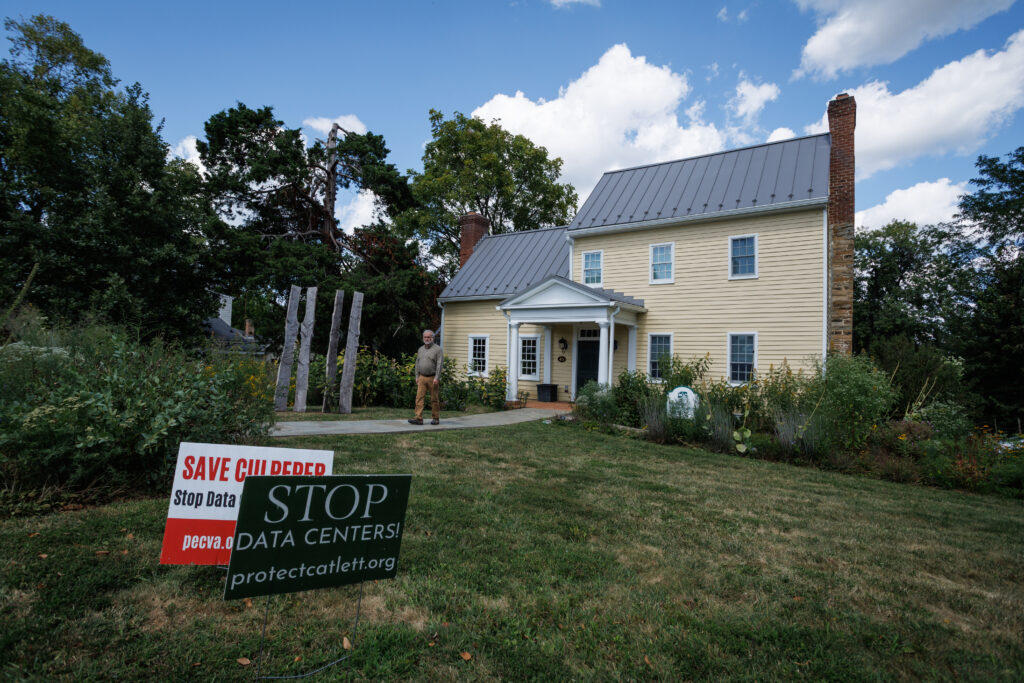Local environmental group wants guardrails on AI-fueled boom
The Piedmont Environment Council (PEC), after 53 years of thoughtfully protecting the lands and waters of the Virginia Piedmont, finds itself on the front lines of a David and Goliath face-off with Big Tech.
The moment for the conservation nonprofit is “transformative,” said John McCarthy, PEC’s senior advisor and director of strategic partnerships. McCarthy, who was Rapphannock’s longtime county administrator, added that the challenge is both “energizing and enervating.”
Stated most starkly, the Warrenton-based organization — with a staff of 50, up from about 30 four years ago — is staring down the seven dominant technology giants that have turned Virginia into the epicenter for data centers, supplying the computing power required by the super-sector of artificial intelligence, or AI.
The companies — Apple, Microsoft, Nvidia, Amazon, Alphabet, Meta and Tesla — have a combined capitalization of $19.41 trillion. To put this in perspective, the U.S. Gross Domestic Product, the accepted measure for the country’s entire economy, is calculated to be $30.3 trillion currently.
A typical week finds PEC’s senior staff sounding alarms about the galloping proliferation of data centers and the voracious demands they will make on the state’s energy and water resources. They are tracking zoning and environmental reviews among county governments, while chasing down details on newly proposed AI-related investments as they surface. They shape their research into concise messages that an outside firm under contract with PEC pushes out as email blasts and social media alerts.
Entering the fray
On Aug. 27, Alphabet’s Google announced $9 billion of planned Virginia investments, including a new data center in Chesterfield County outside Richmond, plus expansions of existing campuses in Loudoun and Prince William counties.
Virginia Gov. Glenn Youngkin hurried onto the X social media platform to declare: “Another historic win for Virginia!…Together with our AI Career Launch Pad, this new investment positions Virginia at the forefront of AI talent and innovation.”
A couple of hours later, PEC President Christopher Miller entered the fray with a more sobering message: “After the excitement dies down about Google’s announcement…local officials need to face reality and insist on transparency with regard to the company’s more precise plans.”
He went on to exhort the General Assembly and State Corporation Commission “to protect citizens and other businesses and ensure they are not bearing the brunt of the cost of the infrastructure needed to support the commercial interests of one of the largest and most profitable global companies.”
Miller, meeting continuously with groups around the state, talks about the aggregate effects of the data centers, honing in on how much electricity and water they will consume. For many, the wake-up message is that ordinary citizens will be stuck with whopping increases in their electricity bills so that Dominion Energy can generate and transmit the enormous increases in power that the data centers will require. That’s on top of an unprecedented loss of open landscape.
Earlier this month, unveiling the PEC campaign, “Virginians for a Smarter Digital Future,” Miller charged that “data center developers are pushing rapid development that is ruining our communities, degrading air quality, and putting an unfair burden on ratepayers regardless of where they live in the state.“
PEC focuses on land use and conservation in nine counties, including Rappahannock. Though the data centers are proliferating most intensively in Loudoun, Prince William, Fauquier and Culpeper, Miller is driving home the point that neighboring counties will be significantly affected.
Though Rappahannock is resisting data center construction within the county, its residents will bear some of the costs for providing power for data center campuses in Fauquier, Culpeper, Loudoun and elsewhere. In fact, electricity rates are already on the rise. Beyond that, Rappahannock can expect new proposals for transmission lines and substations to meet the new energy demands.
Rappahannock residents react strongly when utilities propose enlarging or expanding power lines. Currently, citizens are squaring off with Potomac Edison, an electric utility, which wants to replace a 13.8-mile stretch of power lines and poles from Luray, over the Shenandoah National Park and through Sperryville. The new structures would be taller and more imposing than those they would replace, and citizens are acutely worried about spoiling the views that contribute centrally to their sense of life in Rappahannock. The plan, and the reactions, could be a rehearsal for battles facing the county when plans for powering the data centers take shape.

John McCarthy at Piedmont Environmental Council headquarters in Warrenton, Va. (Photo/Luke Christopher)
Treading a delicate line
PEC treads a delicate line on AI, which economists figure may pull in as much as $600 billion in investments across the U.S. this year. Politically, AI has become a hard-to-oppose economic stimulus at a time the Trump administration’s tariffs threaten to push up inflation while slowing economic activity. Both Republicans and Democrats support the U.S. push to dominate the newly emerging super-sector.
“What we’re doing is not just saying, ‘No,’” said PEC Board Chair David Aldrich. “The message is more like, ‘Maybe, but…’ ”
In coming months, PEC is expected to spell out more precisely what guardrails and investments would make data centers less disruptive. PEC officials are studying a range of ideas, including more underground transmission lines, on-site power generators for some data campuses, and mapping AI-structures into defined corridors. Another idea is that data center operators finance “mitigation projects,” such as conservation protections outside the AI corridors to offset the negative impacts the bulky computing structures have imposed on the Piedmont landscape.
The data center battle isn’t the first time PEC has stood up to corporate power. In the 1990s, the group successfully opposed the Disney America theme park envisioned for Haymarket, and earlier fought back plans for uranium mining in central Virginia. However, the companies pursuing AI domination are far larger than those involved in these earlier projects. And Disney, unlike Big Tech, was intensely sensitive to public opinion, and dropped the plan in the face of formidable local opposition.
Though Virginia is the epicenter, the AI boom has ignited data center construction plans across the nation, and PEC is now sharing lessons of experience with far-flung civil society groups seeking to press the pause button. In recent months, the nonprofit has offered guidance, tactical insights and information to individuals and organizations that have gotten in touch from Pennsylvania, Georgia, Tennessee, North Carolina, Oregon, Wisconsin, New York, New Mexico, Maryland and Delaware.
“It’s working on a national problem,” said Mike Wenger, a board member of the Rappahannock League for Environmental Protection, which often collaborates with PEC to address proposals for power lines and energy infrastructure. But he notes that alongside the struggle with the technology behemoths, “PEC does very, very micro kinds of stuff that’s very important,” such as helping property owners place land under conservation easements.
Signs of pause, pushback
There are some signs that PEC’s efforts to slow the data center rush are making a difference. In August, backers of the giant Gigaland data center proposed for Remington, a small Fauquier town, withdrew their proposal, which had met with resistance from citizens and local authorities. PEC issued an email blast applauding the move as a “victory and a testament to the power of civic engagement.”
However, Gigaland LLC is reformulating the proposed project, not burying it, and Remington is sorting out three other giant data center plans, hatched by other AI-related companies.
Amazon’s proposal for a data center in Warrenton is stalled by a lawsuit. Meanwhile, the Warrenton Town Council will consider a ban on data centers within the boundaries of the town. At the state level, proposed legislation to curb data center construction has been proposed, but never enacted.
Separately, hundreds of Virginians, many alerted by PEC, have written to the State Corporation Commission (SCC) in Richmond to blast Dominion Energy’s proposed plan to hike rates for electricity.
“It is absolutely unacceptable that corporations that want to build data centers in Virginia, that will put even more stress on our electrical infrastructure, would pass that cost onto private citizens,” wrote Vincent Muscarella of Waynesboro.
“Make corporations pay for the data centers, not consumers,” wrote Frances Valentine of Virginia Beach. “If you do this we will sue you!”
The SCC has closed the period for written comments on Dominion’s plans, and must come to a decision before the end of the year.
The data center campaign by most estimates is in its early stages. For PEC, the challenge isn’t regarded as mission-creep, but flows from the organization’s core commitment to “protect and restore the lands and waters of the Virginia Piedmont.”
“This wasn’t a fight we were looking for,” said McCarthy. ”It found us.”





